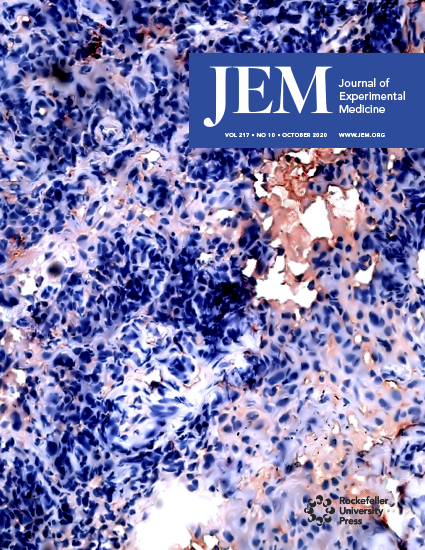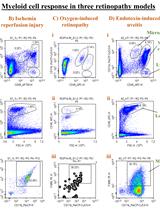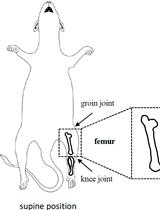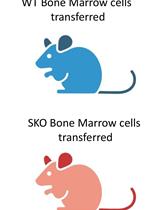- EN - English
- CN - 中文
Multi-color Flow Cytometry for Comprehensive Analysis of the Tumor Immune Infiltrate in a Murine Model of Breast Cancer
多色流式细胞术综合分析乳腺癌小鼠模型中肿瘤免疫渗透
发布: 2021年06月05日第11卷第11期 DOI: 10.21769/BioProtoc.4012 浏览次数: 7850
评审: Marek WagnerAnonymous reviewer(s)
Abstract
Flow cytometry is a popular laser-based technology that allows the phenotypic and functional characterization of individual cells in a high-throughput manner. Here, we describe a detailed procedure for preparing a single-cell suspension from mammary tumors of the mouse mammary tumor virus-polyoma middle T (MMTV-PyMT) and analyzing these cells by multi-color flow cytometry. This protocol can be used to study the following tumor-infiltrating immune cell populations, defined by the expression of cell surface molecules: total leukocytes, tumor-associated macrophages (TAMs), conventional dendritic cells (DCs), CD103-expressing DCs, tumor-associated neutrophils, inflammatory monocytes, natural killer (NK) cells, CD4+ T cells, CD8+ T cells, γδT cells, and regulatory T cells.
Keywords: Flow cytometry (流式细胞术)Background
Tumor-infiltrating immune cells comprise a major part of the tumor microenvironment and play a crucial role in controlling cancer, with both anti- and pro-tumorigenic effects (Dunn et al., 2002; Grivennikov et al., 2010). Inflammation and infiltration of innate immune cells, including macrophages and neutrophils, are necessary to fight infections but, in the case of cancer, often promote the progression of the disease. Cytotoxic T cells and natural killer (NK) cells can destroy tumors, but cancer cells have developed several mechanisms to evade immune destruction (Dunn et al., 2002; DeNardo et al., 2010). For instance, cancer cells can secrete cytokines that directly inhibit cytotoxic CD8+ T cells and recruit regulatory T cells (Tregs) and myeloid-derived suppressor cells (MDSCs) (Beatty and Gladney, 2015).
Tumoral immune cell infiltration can be prognostic in some breast cancer subtypes (DeNardo et al., 2011). For instance, high lymphocyte infiltration is associated with increased survival in breast cancer patients and a favorable prognosis (Ménard et al., 1997). In addition, clinical studies have shown that the accumulation of tumor-associated macrophages (TAMs) is strongly correlated with poor prognosis in breast cancer (Noy and Pollard, 2014).
Over the past two decades, advances in multi-color flow cytometry have allowed researchers to gain insights into the role of immune cells within the tumor microenvironment. Flow cytometry is widely used to characterize and quantify different cell types in heterogeneous cell populations, such as tumors, by detecting cell surface and intracellular molecules (Perfetto et al., 2004).
Here, to investigate immune cell infiltration during tumor development, we utilized the mouse mammary tumor virus-polyoma middle T (MMTV-PyMT) model of luminal B breast cancer, where the polyoma virus middle T antigen is expressed under the direction of the mouse mammary tumor virus promoter (Lin et al., 2003; Fein et al., 2020). This protocol was optimized for use with mouse mammary tumors, where immune cells may represent 20-40% of total cells. This protocol has two major steps: first, we prepare a single-cell suspension of the mouse mammary tumors, and second, we use multi-color flow cytometry to identify different immune cell subsets. We used this protocol to identify and characterize the following tumor-infiltrating immune cell populations: TAMs, conventional dendritic cells (DCs), CD103-expressing DCs, tumor-associated neutrophils, inflammatory monocytes, NK cells, CD4+ T cells, CD8+ T cells, γδT cells, and Tregs. Other immune cell types can be studied (e.g., B cells), depending on the aim of the experiment. This protocol can also be used with other mouse models of breast cancer (i.e., orthotopic transplantation models based on cell lines, such as the 4T1) and can be easily adapted to other murine cancer models.
Materials and Reagents
Multi-channel pipette 200 μl + 200 μl tips
Multi-dispenser pipette 1,000 μl + 1,000 μl tips
60 mm × 15 mm Petri dish (Sigma, catalog number: P5481)
Cell strainers 70 μm or 100 μm nylon (Falcon, catalog number: 352350 or 352360)
Falcon conical tubes (15 ml, 50 ml) (Falcon, catalog numbers: 352196 and 352070)
1 ml sterile syringes (Fisher Scientific, catalog number: 15889142)
5 ml, 10 ml, and 25 ml pipettes (VWR, catalog numbers: 612-3702, 612-3700, and 612-3698)
Eppendorf tubes 1.5 ml
Scalpels
Parafilm
Fluorescence-activated cell sorting (FACS) tubes with cell strainer (Corning, catalog number: 352235)
FACS tubes polystyrene 5 ml round bottom 12 × 75 mm (Corning, catalog number: 352052)
UltraComp eBeads compensation beads (eBiosciences, catalog number: 01-2222-42), store at 4 °C
96-wells V-/conical-bottom plates (Sarstedt, catalog number: 82.1583.001)
Note: Alternatively, we have used round-bottom plates with similar results.
1× Dulbecco’s Phosphate-Buffered Saline (PBS) (sterile, without Ca++ and Mg++) (Gibco, catalog number: 14190144), store at room temperature
Hank’s balanced salt solution (HBSS) (Gibco, catalog number: 14170112), store at 4 °C
0.02% Sodium Azide (Sigma, catalog number: S2002), store at 4 °C
Bovine serum albumin (BSA) lyophilized powder, suitable for cell culture (Sigma, catalog number: A9418), store at 4 °C
RPMI 1640 (Gibco, catalog number: 21875034), store at 4 °C
Red Blood Cell Lysing (RBCL) buffer Hybri-Max (Sigma, catalog number: R7757), store at room temperature
Collagenase IV (Sigma, catalog number: C5138), store at -20 °C
DNase I recombinant, RNase-free, 10 U/μl (Roche, catalog number: 4716728001), store at -20 °C
Trypan blue solution (Gibco, catalog number: 15250061), store at room temperature
Purified anti-mouse CD16/CD32 (Fc block) (Biolegend, catalog number: 101302), store at 4 °C
Zombie Red Fixable Viability Kit (Biolegend, catalog number: 423109), store at 4 °C
True-Nuclear Transcription Factor Buffer Set (Biolegend, catalog number: 424401), store at -20 °C
Dissociation buffer (see Recipes)
DPBS (or HBSS) with 0.5% BSA (see Recipes)
10% Sodium azide stock solution (see Recipes)
Ice-cold FACS buffer (see Recipes)
FACS antibodies (see Table 1)
Table 1. Flow antibodies information
Antibody Fluorophore Host Clone IgG subtype Catalog no. Producer CD45 eFluor450 Rat 30-F11 IgG2b, kappa 48-0451-82 eBiosciences MHC II APC-eFluor780 Rat M5/114.15.2 IgG2b, kappa 47-5321-82 eBiosciences CD103 PE Armenian Hamster 2E7 IgG 121405 Biolegend CD3 FITC Rat 17A2 IgG2b, kappa 100203 Biolegend CD4 PerCP/Cy5.5 Rat RM4-4 IgG2b, kappa 116011 Biolegend CD11b FITC Rat M1/70 IgG2b, kappa 101205 Biolegend CD11c APC Armenian Hamster N418 IgG 117309 Biolegend F4/80 PerCP/Cy5.5 Rat BM8 IgG2a, kappa 123127 Biolegend CD8 AF700 Rat 53-6.7 IgG2a, kappa 100729 Biolegend NKp46/CD335 PE Rat 29A1.4 IgG2a, kappa 137603 Biolegend γδTCR APC Armenian Hamster GL3 IgG 118115 Biolegend FOXP3 PE Rat NRRF-30 IgG2a, kappa 14-4771-80 eBiosciences
Equipment
Pipettor (e.g., Pipet-Aid)
Counting chamber slides or a hemacytometer
Dissection tools (Fine Science Tools)
Caliper (to measure tumor size) (Fine Science Tools, catalog number: 30087-00)
BD LSRII flow cytometer (BD, Franklin Lakes, NJ)
Four-laser setup: Violet (403 nm), Blue (488 nm), Yellow/Green (561 nm), and Red (640 nm). This protocol is written for analysis on a BD LSRII flow cytometer, but it can be easily adapted for use with any 4-laser cytometer. The availability of the lasers and the configuration of the mirrors in the user’s cytometer will determine which fluorochromes can be used.
Shaker incubator at 37 °C
Table-top centrifuge (with plates adaptor) at room temperature and 4 °C
Automated cell counter (Invitrogen) or a light microscope
Bench-top vortex with a 96-well plate adaptor (optional)
Software
FlowJo (BD, version 10, https://www.flowjo.com/)
GraphPad Prism (GraphPad, version 8, https://www.graphpad.com/)
Procedure
文章信息
版权信息
© 2021 The Authors; exclusive licensee Bio-protocol LLC.
如何引用
Almeida, A. S., Fein, M. R. and Egeblad, M. (2021). Multi-color Flow Cytometry for Comprehensive Analysis of the Tumor Immune Infiltrate in a Murine Model of Breast Cancer. Bio-protocol 11(11): e4012. DOI: 10.21769/BioProtoc.4012.
分类
免疫学 > 免疫细胞染色 > 流式细胞术
癌症生物学 > 肿瘤免疫学 > 动物模型
您对这篇实验方法有问题吗?
在此处发布您的问题,我们将邀请本文作者来回答。同时,我们会将您的问题发布到Bio-protocol Exchange,以便寻求社区成员的帮助。
提问指南
+ 问题描述
写下详细的问题描述,包括所有有助于他人回答您问题的信息(例如实验过程、条件和相关图像等)。
Share
Bluesky
X
Copy link












